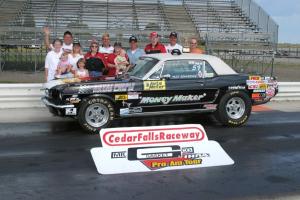|
Author
|
Topic: Connecting Rod Machining
|
n2oMike
Gearhead Posts: 2419
From: Spencer, WV
Registered: Jan 2001
|
 posted 07-05-2003 05:55 PM
posted 07-05-2003 05:55 PM
   
I recently picked up my Boss 302 rods from the machine shop. I had ARP Wavelock bolts installed and had them reconditioned. (yes, this is the 2nd time, as they were too tight) The problem is, they are not round. The shop says, sometimes the width at the parting line will not 'suck in' and they will be larger side to side than up and down. They said the up and down measurement is the one that counts.
Are they feeding my a line of bullsh*t? I've heard of making the rod's big ends slightly wider than they are tall to keep the bearing half from scraping the oil film under tension, but how much is too much? I'll be back later with more precise measurements.Thanks! ------------------
Mike Burch
66 mustang real street
302 4-speed 289 heads
10.63 @ 129.3
http://www.geocities.com/carbedstangs/cmml_mburch.html
http://www.fortunecity.com/silverstone/healey/367
http://www.mustangworks.com/cgi-bin/moi-display.cgi?220
IP: Logged |
ted
Journeyman Posts: 62
From: Central Texas
Registered: May 2003
|
 posted 07-05-2003 11:05 PM
posted 07-05-2003 11:05 PM
   
How much out of round? My own preference is to resize if more than 0.0005". I'm probably pickier than most on this. Parting lines do tend to be a problem if trying to minimize how much to take off the cap and rod to keep from shortening the rod too much. On the other hand, if the machine shop is only taking material off of the cap and not both the rod and the cap, then the parting line could be more of a problem on the rod side.Although I avoid this method, the quick and easy for fixing parting lines is to machine the cap faces out of square with each other. This is done by first facing off both faces parallel with each other and then coming back and setting a 0.015" feeler gauge under one face while holding slight pressure against the grinding rock and then setting the remaining face directly against the grinding rock. Then just remove the feeler gauge and grind that face that didn't have a feeler gauge under it until the rock sweeps the face all the way across it. It won't take much. The face that had the feeler gauge under it shouldn't be touched at this point. When the cap is torqued on the rod, this will pull the parting lines slightly towards each other so that the area around the parting lines will machine cleanly. Hope that made sense. ------------------
Ted E.
Fe's are plenty fast, but "Y"'s are fun when they run in the nines.
IP: Logged |
kid vishus
Gearhead Posts: 6098
From: middle of NC
Registered: Oct 2000
|
 posted 07-05-2003 11:17 PM
posted 07-05-2003 11:17 PM
   
My rods in my cleveland are resized that way for the same reason the shop explained to you. Just for reference, mine are .0002 top to bottom, and .00035 side to side. I was told by an ex super stock racer that ran clevelands that was a very common practice to machine stock rods that way (before they were allowed to use aftermarket rods). Since I have started having them done that way, I have yet to have a rod bearing failure (and my rod bearings look real good at the end of a season). It may just be coincidence, but it seems to work for me.
IP: Logged |
n2oMike
Gearhead Posts: 2419
From: Spencer, WV
Registered: Jan 2001
|
 posted 07-05-2003 11:40 PM
posted 07-05-2003 11:40 PM
   
Thanks guys.I feel better now. Ted, I'm using waveloc bolts. The waves extend down into the cap, and the shop said it kept the sides of the rods from 'pulling in' when they were re-done. Go figure... KV, I remember you saying something about this in the past... Mine are significantly wider on the sides. Your info makes me feel MUCH better.
Thanks guys! Mike ------------------
Mike Burch
66 mustang real street
302 4-speed 289 heads
10.63 @ 129.3
http://www.geocities.com/carbedstangs/cmml_mburch.html
http://www.fortunecity.com/silverstone/healey/367
http://www.mustangworks.com/cgi-bin/moi-display.cgi?220 [This message has been edited by n2oMike (edited 07-05-2003).]
IP: Logged |
ted
Journeyman Posts: 62
From: Central Texas
Registered: May 2003
|
 posted 07-06-2003 09:08 AM
posted 07-06-2003 09:08 AM
   
Sort of related but on a different train of thought. The rod bearings themselves are slightly thinner at the parting lines to compensate for any crush and the subsequent pushing out of bearing material towards the rod journal when torquing down the bearings. For this reason, the bearings typically always shows more clearance in the area around the parting lines than in the other areas of the bearing when checking clearances. When I say more, I'm talking mere tenths of a thousand's.------------------
Ted E.
Fe's are plenty fast, but "Y"'s are fun when they run in the nines.
IP: Logged |







 Mustangsandmore Forums
Mustangsandmore Forums

 Ford Racing
Ford Racing

 Connecting Rod Machining
Connecting Rod Machining


